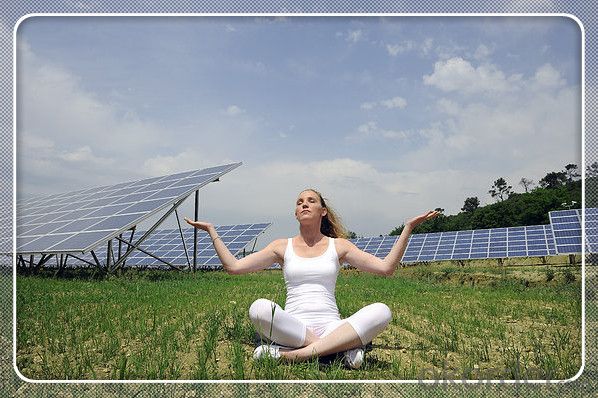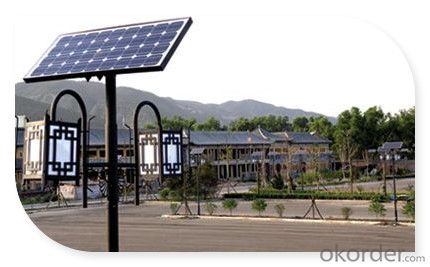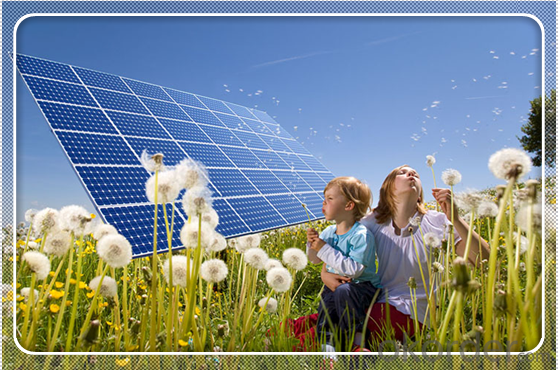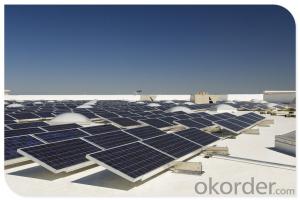60W Efficiency Photovoltaic Chinese Solar Panels For Sale 5-200W
- Loading Port:
- China main port
- Payment Terms:
- TT OR LC
- Min Order Qty:
- 10000 watt
- Supply Capability:
- 100000 watt/month
OKorder Service Pledge
OKorder Financial Service
You Might Also Like
Item specifice




Solar Module Introduction
Solar Module is the core part of solar PV power systems, also is the highest value part of it. The function of Solar Module is to convert the sun's radiation to electrical energy, or transfer it to battery and store in it, or to drive the load running.
The Product has been widely used in space and ground, it mainly used for power generation systems, charging systems, road lighting and traffic signs areas. It could offer a wide range of power and voltage, and with high conversion efficiency, and long service life.
Solar modules use light energy (photons) from the sun to generate electricity through the photovoltaic effect. The majority of modules use wafer-based crystalline silicon cells or thin-film cells based on cadmium telluride or silicon. The structural (load carrying) member of a module can either be the top layer or the back layer. Cells must also be protected from mechanical damage and moisture. Most solar modules are rigid, but semi-flexible ones are available, based on thin-film cells. These early solar modules were first used in space in 1958.
Electrical connections are made in series to achieve a desired output voltage and/or in parallel to provide a desired current capability. The conducting wires that take the current off the modules may contain silver, copper or other non-magnetic conductive transition metals. The cells must be connected electrically to one another and to the rest of the system. Externally, popular terrestrial usage photovoltaic modules use MC3 (older) or MC4 connectors to facilitate easy weatherproof connections to the rest of the system.
Secification
Model Type | |
Peak Power-Pmax(W) | 5-200W |
Open Circuit Voltage-Voc(V) | 44.2 |
Maximum Power Voltage-Vmp(V) | 36 |
Short Circuit Current-Isc(A) | 5.4 |
Maximum Power Current-Imp(A) | 5 |
Maximum System Voltage | 1000V DC |
Maximum Series Fuse Rating | 10A |
Power Tolerance | -1~+3% |
Temperature Coefficients of Pmax | -0.45%/℃ |
Temperature Coefficients of Voc | -0.348%/℃ |
Temperature Coefficients of Isc | 0.031%/℃ |
Nominal Operating Cell Temperature | 44.5±2℃ |
Standard Testing Condition(STC) | Irradiance:1000W/m²;Temperature:25℃;AM=1.5 |
Qualification Test Parameters | |
Operating Temperature | -40℃~+85℃ |
Storage Temperature | -40℃~+85℃ |
Pressure Bearing | ≥5400Pascal/m² |
Wind Bearing | ≥5400Pascal/m² |
Mechanical Characteristics | |
Cell Size | Mono 125*125mm±0.5 |
No.of Cells | 72pcs(6*12) |
Dimension | 1580*808*40mm |
Weight | 15.5Kg |
Glass | 3.2mm High Transmission,Low Iron |
Frame | Anodized Aluminum Alloy |
Junction Box | IP65Rated |
Internal Diodes | 3 Bypass Diodes |
Cable | 1*4.0mm² Length 900mm |
Images
Packing & Shipping:
We have rich experience on how to pack the panels to make sure the safety on shipment when it arrives at the destination.
The normal size is packed by 25pcs/ carton / pallet. Paper carton for FCL shipping and wood carton for LCL shipping.
Warranty:
For c-Si panel: 25years output warranty for no less than 80% of performance, 10 years output warranty for no less than 90% of performance. Free from material and workmanship defects within 5 years.
For a-Si panel: 20 years output warranty for no less than 80% of performance, 10 years output warranty for no less than 90% of performance. Free from material and workmanship defects within 2 years.
FAQ:
(1)What price for each watt?
It depends on the quantity, delivery date and payment terms.
(2)What is your size for each module? Can you tell me the Parameter of your module?
We have different series of panels in different output, both c-Si and a-Si. Please take the specification sheet for your reference.
(3)Can you provide the peripheral products of the solar panels, such as the battery, controller, and inverter? If so, can you tell me how do they match each other?
Actually we are only manufacturer of solar panels, but we could try to source them for you in China if you need. We could provide you an optimal system design to instruct you how to install.
(4)Do you have the CE, TUV, UL Certification?
We’ve already passed all the tests, and any certificate is available.
(5)Have you ever sold your products to companies in my country?
Of course, we have customers in all general PV markets, but I think we should expand our market share along with the market growth.
(6)When did your company set up? You are a new company, how can I believe your quality?
We entered into Solar PV industry in 2005, now we have several plants in manufacturing of a-Si and c-Si panels, and our capacity is 220MW per year. Till now we have already passed all the tests by authorized laboratories, e.g. TUV, VDE, UL.
(7)Can you help us install the module if we cooperate with you?
We haven’t entered into installation sector, but we have the plan in near future.
(8) How do you pack your products?
We have rich experience on how to pack the panels to make sure the safety on shipment when it arrives at the destination.
(9) Can you do OEM for us?
Yes, we can.
(10)Can we visit your factory?
Surely, I will arrange the trip basing on your business schedule.
- Q:Can solar panels be used for powering a museum or cultural institution?
- Yes, solar panels can certainly be used to power a museum or cultural institution. Solar panels generate electricity by converting sunlight into energy, and this renewable energy source can effectively meet the power needs of such establishments. By installing solar panels on the building's roof or in nearby open spaces, museums and cultural institutions can reduce their dependence on traditional energy sources, lower their carbon footprint, and potentially even generate excess electricity that can be fed back into the grid. Additionally, embracing solar power aligns with the sustainable and environmentally conscious image often associated with these institutions.
- Q:Can solar panels be used to power a water treatment plant?
- Yes, solar panels can be used to power a water treatment plant. Solar energy can be harnessed to generate electricity, which can then be used to operate the various processes and equipment involved in water treatment. The energy generated by solar panels can be stored in batteries for use during non-sunny periods, ensuring a consistent power supply for the water treatment plant. Additionally, solar power can help reduce the carbon footprint of the water treatment process, making it more environmentally friendly.
- Q:how to use a motor with solar panel
- photograph voltaic capability is somewhat fluctuating capability source and so it may be greater advantageous if u could save the photograph voltaic capability in a battery. The battery is then related to the motor. returned connect the motor with a zener diode to the photograph voltaic panel because of the fact if u dont u could have a case of decrease back emf producing from the motor and getting discharged interior the photograph voltaic panel that could injury it. further the battery additionally ought to be having a diode circuit which might avert it style discharging into the photograph voltaic panel. hoping that this facilitates..
- Q:How long does it take a 5 watt, 2 volt solar panel to charge a 2 volt R.V. battery?
- Most solar panels have something called a charge controller on them. This prevents electricity from going backwards from the battery to the panel. Solar panels are rated at 2V but they do put out a little more than that during full sun operation. You didn't specify the size of your battery but it really doesn't matter. It comes down to your consumption of power. If you are only charging the RV battery so it maintains a charge when you don't use it very much, a 5 watt panel is fine. It will charge the battery and keep the small drains on the battery from making it go dead ( the clock radio, the theft deterrent system, etc use power even when RV is off) But if you are using the battery to run things when you are parked, you probably don't have a big enough panel. If you use a 30watt fluorescent light and a 00 watt laptop, you need 30 watts of power saved up every hour in your battery and that's with no inefficiencies. So if your panel puts out 5 watts an hour and you are using 30 watts an hour, you need 30 watts/ 5 watts = 9 hours minimum of charge time to run your stuff for just one hour. You probably need a panel of around a 00 watts to get any meaningful use of your battery. Plus, you never want to run your battery to full drain because it ruins the plates inside the battery. Watts = volts x amps. If you have 2 volts panels, you would charge at 8 amps with a 00 watt panel. This is a good charge rate. Any more than this and you risk warping the plates with too much heat.
- Q:I mean when light hits the solar panel where does the energy go and what does it become? Be specific.
- Energy is conserved, meaning that no energy is lost. It has to go somewhere. So for solar panels, the main energy is electricity. The current that is produced by all of those silicon wafers is usually stored in DC batteries. Some of the energy from the sun is transferred into heat. Perhaps a Mechanical Engineer can better answer if any very minute expansion occurs from the sun. I would guess negligible.
- Q:Can solar panels be installed on flat roofs?
- Yes, solar panels can be installed on flat roofs. In fact, flat roofs are often considered ideal for solar panel installations due to their easy accessibility and the ability to optimize panel positioning. However, it is important to conduct a structural analysis and ensure proper waterproofing measures are taken during the installation process.
- Q:Hi, wanting to set up the most basic solar panel system for a cabin in the woods that has enough power to recharge four 2V car batteries during the daytime (i am assuming; we want to run a mini fridge maybe a stove and a few lights at night off the batteries and be able to run it all just off solar during the day) It also needs to be able to power some simple tools during the day... Experience would be absolutely amazing since alot of the info on solar paneling is either really dumbed down, or ridiculously confusing.As of right now I am looking at a 3 panel (45watt in all) solar kit that needs a 300w inverter.... is this sufficient for my power needs? I am just a little perplexed, thanks so much!
- That okorder /... , but expect to pay several thousand dollars for something that actually works. If you just want to use the place for intermittent getaways, a generator may be sufficient, and you can skip the solar panels. If you intend to live in the place, then consider getting a system that is at least 500-000 watts of panels, and a 000 amp-hour or more battery bank.
- Q:Can solar panels be installed on historical or protected buildings?
- Yes, solar panels can be installed on historical or protected buildings. However, there are certain considerations and guidelines that need to be followed to ensure that the installation does not compromise the architectural integrity or cultural significance of the building. Special care is taken to design and install solar panels in a way that minimizes visual impact and preserves the historical value of the structure. Additionally, obtaining necessary permissions and approvals from relevant authorities is crucial before proceeding with the installation.
- Q:I have an electric bicycle that I travel to work by, pulling a modified child carrying trailer that holds two 2 volt deep cycle batteries in series to power the 24 volt bike motor. I'm thinking about adding a 50 watt solar panel (or larger depending on the room I can make available) to charge while I'm at work and to provide some extra juice while on my more distant travels.Can I get a solar panel to charge them while they're connected the way they are: in series? Does charging work that way?I've read that in order to charge the 24 volt battery setup (if the answer to the Q above is yes), the output from my solar panel would need to be a little more than 24 volts. Is this true? If so, how many volts?Since the bike is supposed to be powered at 24 volts and I have an x-volt (x gt; 24v) solar panel connected to it, will this cause any damage to the controller or other components while running them?Will it help supply power even while the motor is being run?Thanks.
- You did not give the AH rate from your 24V battery pack,therefore , unable to suggest a correct current rate solar panel. The solar panel open voltage rate at least 30V to charge a 24V cell. No harm to controller since the charging current is so small even bike is in running condition.
- Q:How do solar panels affect the insurance premiums of a property?
- Solar panels can have both positive and negative effects on insurance premiums. On one hand, having solar panels installed on a property can increase its overall value, which may lead to higher replacement costs in case of damage or loss. This could potentially increase insurance premiums. However, many insurance companies also offer discounts for properties with solar panels, as they are considered a risk mitigation measure. The extent to which solar panels affect insurance premiums can vary depending on the specific policies and guidelines of the insurance provider.
1. Manufacturer Overview |
|
|---|---|
| Location | |
| Year Established | |
| Annual Output Value | |
| Main Markets | |
| Company Certifications | |
2. Manufacturer Certificates |
|
|---|---|
| a) Certification Name | |
| Range | |
| Reference | |
| Validity Period | |
3. Manufacturer Capability |
|
|---|---|
| a)Trade Capacity | |
| Nearest Port | |
| Export Percentage | |
| No.of Employees in Trade Department | |
| Language Spoken: | |
| b)Factory Information | |
| Factory Size: | |
| No. of Production Lines | |
| Contract Manufacturing | |
| Product Price Range | |
Send your message to us
60W Efficiency Photovoltaic Chinese Solar Panels For Sale 5-200W
- Loading Port:
- China main port
- Payment Terms:
- TT OR LC
- Min Order Qty:
- 10000 watt
- Supply Capability:
- 100000 watt/month
OKorder Service Pledge
OKorder Financial Service
Similar products
New products
Hot products
Hot Searches
Related keywords





























